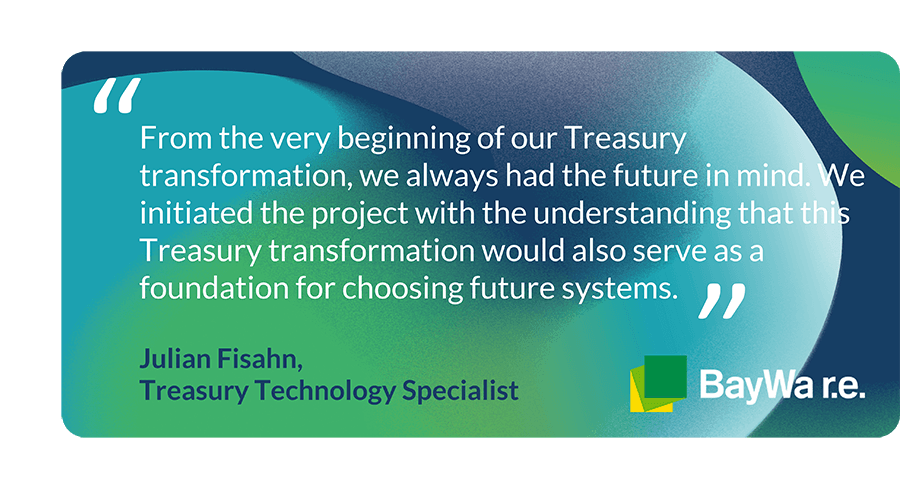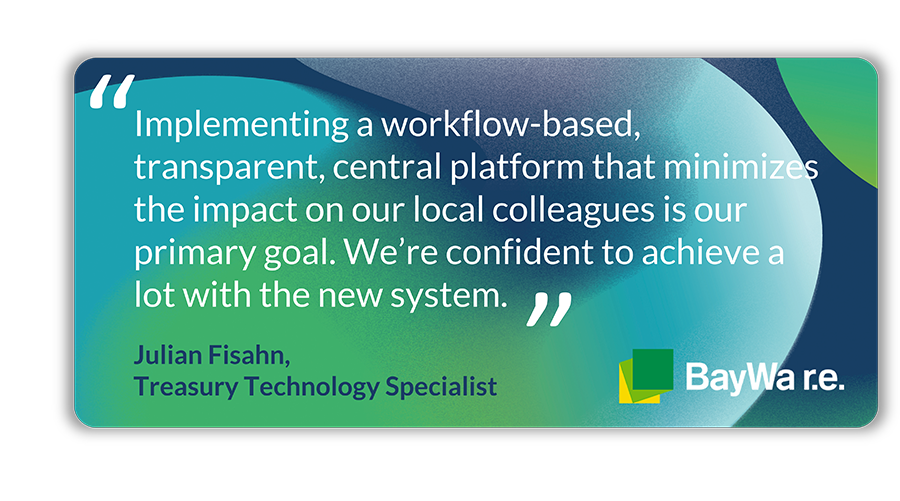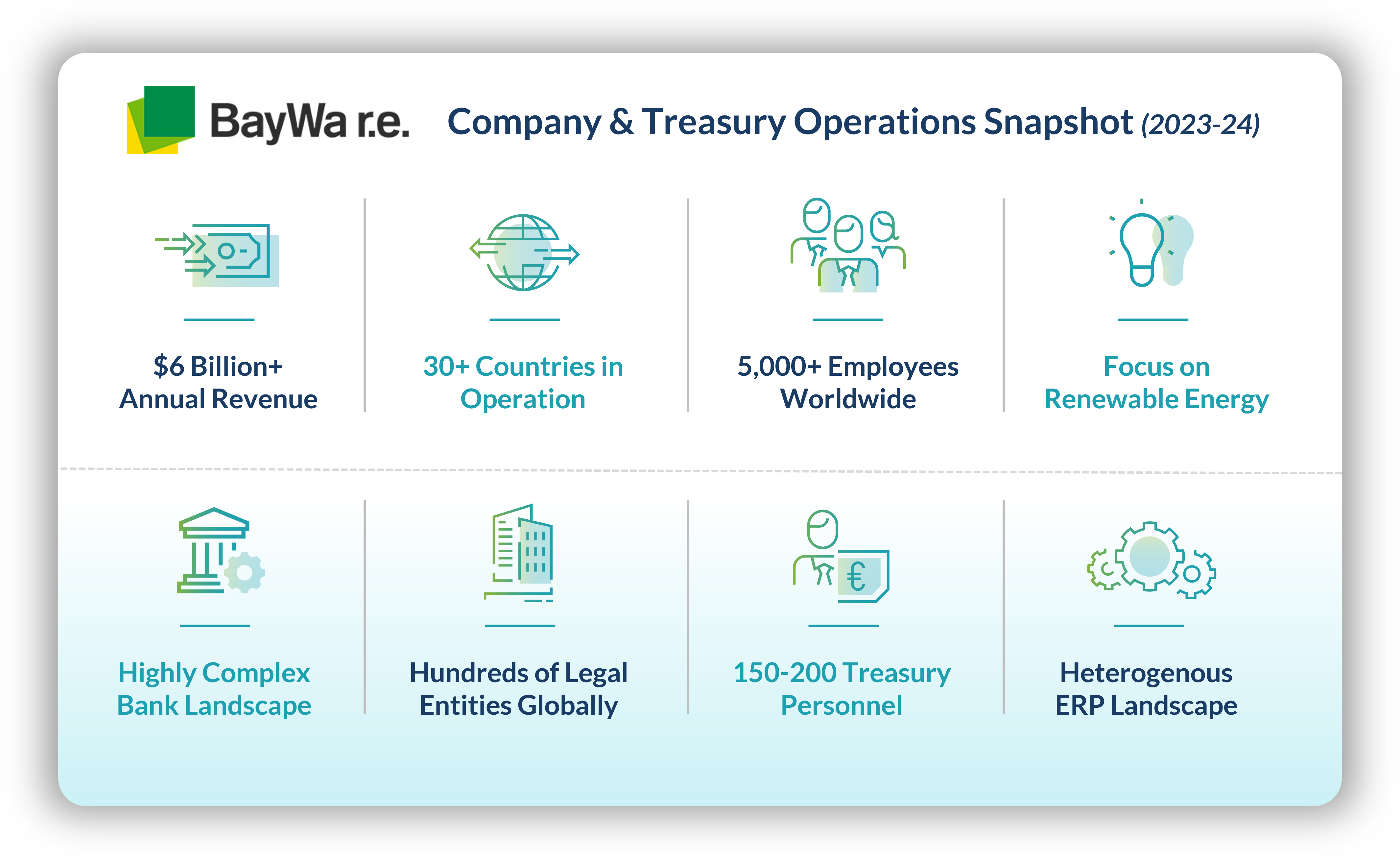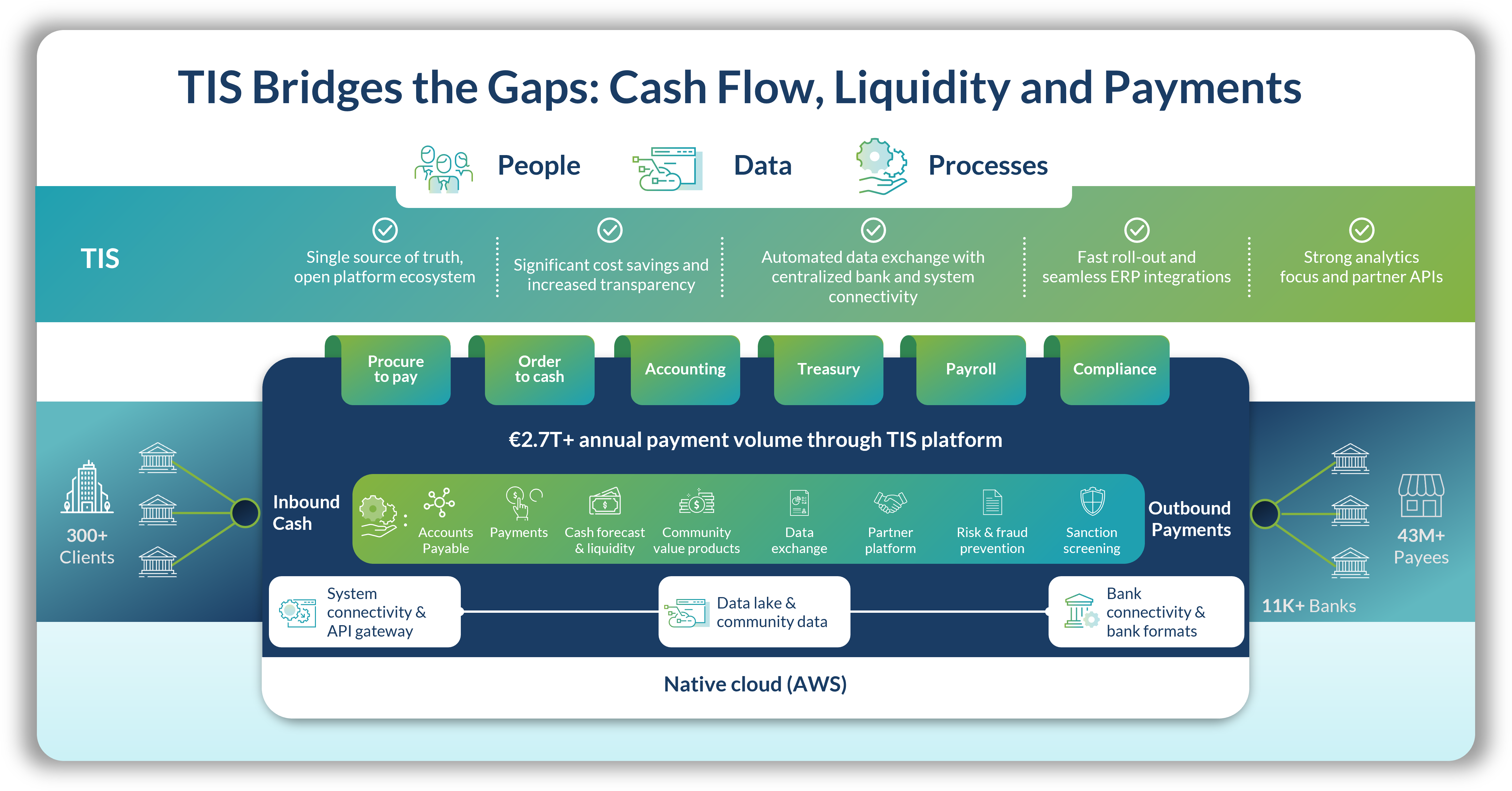Notice: This blog is based on an interview-style conversation between TIS representative Edgar Goldemer and Julian Fisahn, Specialist in Treasury Management Systems at BayWa r.e. The focus of their discussion centers on best practices for managing a treasury technology project – from gathering requirements and aligning with stakeholders to building an RFP, selecting vendors, and kicking off the implementation process. The ultimate goal? Identifying and instituting a platform to manage global financial data integration and process automation for treasury’s core payments and cash management operations.
This article was originally published in the Q1 2024 edition of the TIS magazine. To access the full spread of exclusive magazine articles and industry insights, refer to the above landing page.
Read the Full Interview Between TIS & BayWa r.e. Below
Edgar Goldemer: Julian, can you get us and our readers on board in a few sentences: How did the need for greater financial technology automation arise for your treasury group? What is the backdrop of the RfP which ultimately led to identifying TIS as a vendor?
Julian Fisahn: Certainly! Within BayWa r.e.’s Treasury, we currently operate on a rather classic setup involving a treasury management system and a reporting tool. However, we’ve realized that these solutions are not scaling with our current growth. Over the last 10 years, BayWa r.e. as a group has experienced significant increases in terms of revenue, global footprint, and the number of newly onboarded employees – including those related to Treasury. Given that our current treasury solutions are not keeping pace with our current growth, we figured that we have to revamp our Treasury setup. Therefore, we initiated an overall Treasury transformation. Encompassing aspects such as organizational design, Target Operating Model definition, and, subsequently, the system selection process. We use all our Target Operating Model decisions as a basis for determining the requirements of our upcoming or new systems.
Edgar: It’s great that BayWa r.e. already had clear objectives and a holistic vision when reaching out to us. The approach they followed is something I would recommend to any company considering a Treasury transformation project. Without a vision or clearly defined goals, sooner or later during the RfP process, companies risk getting lost in individual features and function discussions in the RfP spreadsheet. There are so many details to consider and to evaluate. To avoid losing focus or spending valuable time on something that might actually not be relevant for the operations, having the big picture in front is crucial. It facilitates evaluating features, functions, and strategic conversations. Having defined a vision beforehand can be helpful to zoom out and look at the big picture again.
So, scalability and a future-proof solution for your Treasury to keep up with the pace of your company’s growth was the main focus for BayWa r.e.?
Julian: Yes, partially. In Treasury, we were indeed searching for scalable solutions that we, as a Treasury team, can effectively maintain and administer to a maximum degree. I’m referring here, for example, to the onboarding of new colleagues, functionalities, or of new countries we need to include in our new system landscape. That’s on the one side, that’s the Treasury perspective on things. And on the other side, we are looking at dozens of legacy systems outside of Treasury that our systems need to communicate with. With a strong growth in new markets unavoidably comes the task to integrate older legacy systems from companies we acquired. Our ERP landscape is still very heterogeneous across the whole globe for the BayWa r.e. Group. Therefore, we were looking for system solutions that are seamlessly interfaceable with these legacy systems, ensuring the smooth flow of data and processes from outside of Treasury into Treasury and back. This aspect was a crucial consideration for us throughout the entire system selection process.
Edgar: A dynamically growing business environment is certainly amazing news. However, the challenges it poses on the operations of Treasury departments are remarkable. It’s not just about the numerous legacy systems that you just mentioned. There’s also the international banking landscape, limited IT resources, non-compliant manual processes, a lack of cash visibility, and the people to take into account. The complexity is extraordinary. I believe that each of those factors alone is reason enough for Treasury to seek out and look for a centralized payment hub – a solution that allows for agility and security around the Treasury and payment operations. The more factors come into play, the more entities, or countries, the higher the overall complexity is, the more important it is to have a really robust and dedicated payment hub.
How many systems and countries were in scope for the treasury transformation project you aimed to start?
Julian: Currently, we operate on thirty different ERP instances, involving a lot of different vendors. Additionally, we have master data systems in place, with which we need to exchange data to ensure a full and up-to-date overview on bank accounts, bank partners, and on the relationship to our legal entities. We have hundreds of legal entities, it’s between 600 and 800. The number is pretty fluent in our case.
In summary, there are numerous entities that we need to onboard, each with many bank accounts. So, there’s quite a lot of things to do for us with TIS.
Edgar: Definitely, and we’re looking forward to it! Is it the first time you are conducting a comparable project at such a scale?
Julian: Fortunately, I personally have some experience with Treasury transformation projects and also with system selection and implementation projects. So, this is rather not new to me. And luckily, it’s also not new to our colleagues in Corporate Treasury. We have a very motivated team, which fortunately has a lot of experience with such projects, also from former positions. And, generally speaking, BayWa r.e. is very open to change. I mean, we, as a corporation, have been in a constant change management mode over the last 10 years. So many new countries, legal entities, and systems were onboarded. People here are very used to working in a project context, and excited to drive digital transformation. Everyone you speak to is very open minded and up for change if it’s for the better.
Edgar: It’s a fortunate situation.
Julian: Yes, it is! Being a former consultant, I also experienced very different setups, and this is luckily not the case here. At BayWa r.e., everyone is well aware what it could mean for us to have one online banking tool for the whole group, one central payment hub. How valuable that will be for us. This common understanding is a good basis to tackle the project.
Edgar: Taking a closer look at the people aware of the objectives and benefits of your Treasury transformation project, which stakeholders do companies need to get on board for such a project and how do you recommend approaching them?
Julian: Firstly, I think it’s obviously very important – especially when looking at project sponsors and the management board – to clearly define the need for new systems. We require top management decisions for budgeting such systems. Consequently, we put in a lot of effort to clearly outline why it is worthwhile to contract new systems and why the associated costs are justified. Having the management on board, and also actively supporting is crucial.
As an international corporation with numerous regional holdings and regional corporations within the whole BayWa r.e. Group, we did “internal roadshows“ to inform our colleagues about the new systems and the whole Treasury transformation: What is the value add of transforming Treasury for them? What does it mean for their day-to-day operations? Why will we be able to reduce the workload on their end? In short, why does it make sense to centralize topics, such as bank connectivity and payments with TIS?
We put a lot of effort into these roadshows, bilaterally communicating our project to all our main stakeholders. We have approximately 150 to 200 Treasury representatives actively working together with us in Corporate Treasury, who we were giving a platform to openly discuss the pros and cons and to also let us know their requirements and perspective on what will be important for the future.
Edgar: That’s a great summary. What might be worth adding here is that the factors determining stakeholder involvement heavily depend on the organizational structure and the objectives, system setup, and departments involved. For a company with a highly centralized structure, for example, deep involvement from local entities might not be necessary. There’s no universal answer to the question of who the stakeholders are next to the management.
Depending on the project scope it can be Accounting, Compliance, Data privacy officers as additional stakeholders, but then also Legal. However, in almost all cases IT is a crucial key stakeholder. And, based on my experience with Treasury technology projects, it is wise to involve IT as early as possible, especially if they will be tasked with assisting in financial data integration or other key tasks during the implementation.
What I would always recommend doing, is conducting a stakeholder analysis upfront. Without this, there’s a clear risk of project delays or even a project freeze.
Julian: Yes, I totally agree. We did a thorough stakeholder analysis initially, to gain a nuanced understanding of all our stakeholders, region by region: Who are they? What is their stake in such a project? What kind of arguments do we have to convince them for their buy-in? And then of course, also function by function: Who do we need to involve for which topic, which departments, as outlined by you, including Legal, IT, etc. It is crucial to conduct such an analysis to keep track of the entire development, particularly for communication and understanding our position with each stakeholder in the current process.
Edgar: Based on the analysis you conducted and on the objectives for your new Treasury setup: How did you then make your vendor decisions when receiving the answers to the RfP? Was financial data integration and platform automation a core theme here?
Julian: Of course, we had a requirements list with certain use cases, which we identified as most important for us. And we expected beforehand that the vendors that we shortlisted based on our market experience would tick the boxes somehow similarly. In the end, we all know these nice requirement catalogs. And then there is a vendor with 95%, one with 92%, and another one with 90%. Subsequently, the question arises, how do you choose the right one? That’s a difficult question.
From the very beginning of our Treasury transformation, and as I mentioned earlier, we always had the future in mind. We initiated the project with the understanding that this Treasury transformation would also serve as a foundation for choosing future systems. We asked ourselves: What kind of partners will we have on our side in the future? What will the future day-today basis look like?
We, as the Corporate Treasury, see ourselves as a service provider to the group. We own the Treasury systems, and we will be owning the future ones. It’s crucial for us to be able to administer and maintain both current and future systems ourselves and to ensure a service level agreement of 100% with our legal entities at all times. Especially when it comes to such a sensitive topic as payments. We look at it not only from an operational, but also from a compliance perspective.
Therefore, when analyzing the RfP answers very carefully during the selection phase, we evaluated which system and with which vendor we felt most confident with. Where do we really have a single platform that we can administer and where it all happens centralized, e.g. the onboarding of new banks and legal entities, the maintenance of user signatory rights on the bank accounts, etc.? Being able to manage all these things via a single user interface was a key consideration for us. And additionally, there was always the question: Where do we need to keep up the service, but where do we not want to maintain something ourselves?

Edgar: And what did you not want to maintain yourselves?
Julian: In our case, we decided, we absolutely do not want to handle format translations ourselves. For the vast number of bank or country combinations we deal with results in a remarkable complexity. We lack the experience to build and maintain these in-house, and developing the expertise would be both time- and cost-consuming. Therefore, we clearly opted to outsource this aspect.
And that is how, step by step, we proceeded to make decisions. Through discussions with vendors and in workshops, we understood: with which platform do we feel most confident? Where do we have a strong community as a backbone? Where do we have a multi-tenant cloud environment and constant updates of the format library for example? As I mentioned, our focus was on where we felt most confident in steering the processes ourselves as a Corporate Treasury team, while keeping the IT involvement to a minimum. And ultimately it was TIS we decided on.
Edgar: And now that the project is about to kick off, where do you see the main benefits in your day-to-day operations in the future?
Julian: Currently, I estimate we maintain about 90 or 95 bank and country combinations within the BayWa r.e. Group. So, it’s a lot to take care of. And this will be completely outsourced. Additionally, it is a significant challenge that a considerable number of payments outside of Europe are executed through various online banking tools. These tools require administration by the regional corporations, which is quite unsatisfactory for us as Corporate Treasury.
As mentioned earlier, we see ourselves as a service provider. Our goal is to minimize the effort for our local colleagues when it comes to Treasury operations. We want to provide them with a platform where they can easily request new bank accounts and execute payments seamlessly, without having to maintain things themselves. Implementing a workflow-based, transparent, central platform that minimizes the impact on their end is our primary goal. We’re confident to achieve a lot with the new system.

Edgar: Did the process of the RFP and the discussions with vendors change the scope of your project or did they match your expectations?
Julian: Aside from some minor surprises, it mostly aligned with our expectations. What I find crucial, is to really dive deep into discussions with vendors, specifically exploring day-to-day operations within the future system. Asking detailed questions about the opening or maintaining of certain functionalities for example, like the onboarding of new banks: Is that a self-service in the platform? Can I do that myself with a few clicks, or do I need to open a ticket with the vendor? Step by step, we went through our daily operations and kept asking questions to precisely figure out those nuances, which ultimately determine how well we can work with the system day by day.
Edgar: Let me add one thought to that. As you just highlighted, the RfP process is very dynamic and communicative with the goal to ultimately choose the solution that fits your Treasury operations best. BayWa r.e. and you did an amazing job in taking the time to carefully analyze the offerings and identify what is the most valuable solution for them. A lot comes into play here: strategic and operational considerations, confidence, and also trust. These are factors you cannot clarify by just looking at the answers in an RfP Excel spreadsheet.
Julian: Yes, that’s true. And it’s about anticipating future developments. We did not do the RFP process based on our status quo system architecture, as it will be changing. We have some future challenges ahead and therefore always tried to anticipate developments. Keeping in mind, just as you said: What is our strategic aim? Where do we want to be in three, four, five years, and even beyond that? I think that is important. After all, our objective was finding the right system for the upcoming decade, and not just for the upcoming few years.
Explore more TIS Stories: We hope you enjoyed the insights from this interview and found them helpful. For an extended look into the world of TIS and greater insights on financial data integration, platform automation, and a host of other topics, download the Q1 edition of the TIS magazine! Your free copy can be downloaded on this page.
–





